-
Posts
949 -
Joined
-
Last visited
Content Type
Profiles
Forums
Blogs
Gallery
Events
Store
Posts posted by David Gregory
-
-
I don't know enough about the pieces in question to make a qualified comment on them, which is why I am trying to learn.
However, I cannot accept your conclusion that a change in manufacturing methods, which we will probably never be able to understand, automatically condemns an item as a fake.
I work for an engineering company in which minor changes are made to products on a regular basis. In 10 years from now, I defy anyone to explain why some of them occured, unless you have access to the design and quality assurance documents that we have to keep on file.
Although I accept the possibility that unexplained differences might be due to fakes, it seems to me that any other explanation is simply disregarded in order to support the "fake" argument. Some of the known and accepted facts (e.g. differences) might support the fake theory, but there may well be a huge amount of information that has been lost, or not yet discovered, that would defeat it or support a quite diffferent conclusion.
Unfortunately, there seem to be few, if any, known records of the various manufacturers still available today and the eye witnesses to the production processes probably died some years ago.
I applaud the questioning of items that seem genuinely suspicious (and turn out to be fakes), but there may any number of reasons why changes occured and we might not ever learn why. There may be no conclusive answer, however unpalatable that may seem to people who have a lot of money at stake.
0 -
Dave,
Thanks for the corrections. I'll incorporate them into my list when you have posted them all.
The list I have is very basic and compiled in Access, which allows it to be sorted at will. Please let me know if it is of any use to you and I can send it to you in that or a similar format (Excel or HTML) to save duplicating the work.
Cheers,
David
0 -
Very nice. I covet the bars AND the scanner to show them.
0 -
There is a fake Klein out there that is slightly under 63 mm in diameter that has a slightly different wreath and date. The reverse hinge, rivets, and catch look very good. It is of excellent construction- frankly better than the dotted DKiG. Yet this Klein is accepted as a fake. Why? Because the maker mark, wreath, and date are different than known kleins.
Like Rick, I am not really prepared to spend so much money on something made to fool collectors. Please show this fake and tell us why some Klein-made examples are accepted, and others are considered to be bad.
Now the odd thing about the dotted DKiG is the only resemblance to a zimmerman is the hinge, catch, and perhaps the rivets (I think there is some difference there as well). What more do we need to call this a fake? If the Klein is a fake, and the other deschler, godet, juncker,and zimmerman pieces with incorrect wreaths, maker marks, and dates are fakes, why IS THIS ONE real?
If different = fake, how can a real variant be accepted as such? Are these definitions so absolute?
The only answer so far is that Bill Shea and Kai Winkler say so. Apparently Detlev Neiman as well, according to Darrel. Is that a good reason? Well, I think we can see and think for ourselves. This cross is different than other zimmermans. There is no question of that as the photos illustrate. I really think this is a situation of the dealers trying to promote and sell a new fake at the expense of the collector. That is my opionion, but the differences in this piece and known originals I think clearly supports this contention.Have all of these different pieces appeared only recently or is it possible that there are some in older collections that the majority of collectors who visit forums such as this do not know about? Surely not every surviving piece is in a well-known collection, or is every surviving example known and documented?
For those who believe this is a real piece, please state why this is true. I have demonstrated, with the help of Rick, quite clearly why it is fake. If the only "pro" contention is that Bill Shea and Kai Winkler say so, then I think that any rational collector has their answer. As Rick points out, it is odd indeed that those with the financial incentive to promote this as a period piece are doing so. Ask yourself , "why?" and the answer comes quite quickly.Why do they have state why it is true? I can't follow your conclusion. As far as I am concerned, you have certainly demonstrated that two items display differences. That might be because one of them is a fake, or do you know some reason why they cannot possibly differ and still be right?
Until someone provides reasonable evidence that these pieces have only just started appearing and that they are definitely fakes, I find it very hard to believe that there is a conspiracy by a group of such prominent and closely watched dealers to rob otherwise poverty-stricken collectors who just have to acquire an example of every high-end award under the sun.
The paranoia and price hype attached to these items is one of the reasons why I gave up on Third Reich awards some time ago. That being said, I would still like to keep an open mind and find out more about the pieces without having to invest a small fortune in something that involves such a potentially huge risk.
David
0 -
I bought it at a show in Germany, but I can't remember where (I have the details on file). The seller had a lot of common Baden items and a good selection from the other Imperial states. He suggested it was a late-war piece or Spangenst?ck and other collectors who have examined it in hand feel it is OK.
After comparing it with one of the cheap G?de copies and a rather poor quality version that looked OK on both sides from a distance, but didn't stand up to closer scrutiny, I feel it is either a late-war piece as described, or perhaps a Spangenst?ck from the inter-war period. It displays the sort of wear that suggests that it was worn more than once. Considering the ease with which awards can be swapped around with this type of medal bar and the fact that the bar seems to be in better condition than the Z?hringer L?we, I suspect the order was added to it more recently.
It is not the nicest example I have ever seen, but I am happy with it (or will be unless someone definitely identifies it as bad).
David
0 -
Would 4, 5 or 6 have been allowed to be worn after 1934? Isn't there a long service medal missing somewhere along the line?
David
0 -
I agree with Tony and suggest that the tag might not belong to what the tunic is said to be.
David
0 -
Stijn,
Images like that give the modern logistics expression "just-in-time delivery" a whole new meaning.
They are excellent photos and I look forward to seeing more.
David
0 -
Usually in any are of science, when a new item is presented, the burden of proof is to show that the item is authentic. In militaria, it appears that many times the opposite is true- it is real until proven fake. This is where advanced testing through SEM or IR spec is helpful in dating materials.
Given the deviation from known zimmerman pieces, perhaps you could have the enamel analyzed through IR spec and demonstrate when this was produced. I have done this with the rounder and will have results in a couple of weeks. This process will definitively date the compounds used in the paint such that there is no question regarding the manufacture date.
For the sake of collectors that feel obliged to spend money on scientific research to "believe" that an item is authentic, I hope that the method is reliable and the process is performed correctly.
Are anonymous pieces of metal, paint and enamel really worth this expense and effort?
0 -
The images seem to be offered fairly regularly on German eBay, e.g. auction #6221732903.
0 -
Just for the record, I am not bidding on any of the bits.
I e-mailed the seller earlier this evening and he replied that he had already received a number of messages pointing out the error of his ways.
0 -
What makes it even worse is the fact that the non-combatant Hindenburg cross suggests that the EK2 was also for a non-com, but on the black/white ribbon.
By breaking up the bar, the "seller" (who lives up to his name) has not only destroyed an albeit small piece of history, but probably also reduced the selling value of his offering. The bar combination would almost certainly have sold for more than the sum of its constituent parts, quite apart from any historical "value" the bar may have had before it was destroyed by that careless idiot.
0 -
Detail of the maker's stamp and content:
[attachmentid=14618]
Detail of the rivet:
[attachmentid=14619]
Has anyone else got one to compare?
/David

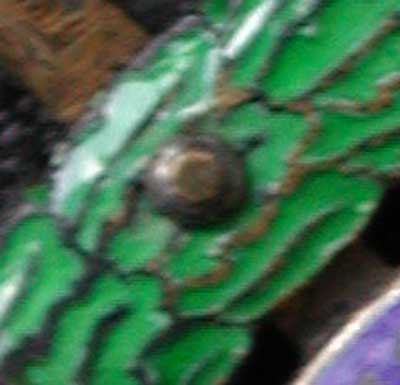

 0
0 -
Although the HHOX is not rare, this version is probably one of the less common. When stocks started to be used up some time in 1916 (so I am told), the remaining stock of awards without swords were converted to the version with swords by having swords attached by rivets.
[attachmentid=14616]
[attachmentid=14617]
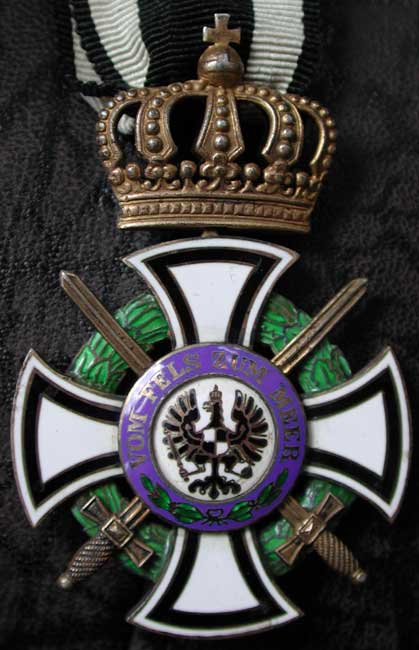
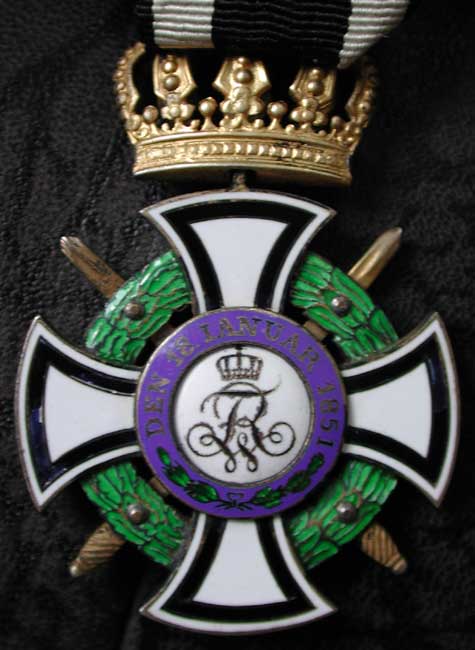

 0
0 -
What a coincidence. I had lunch at Restaurant K?fer on the roof of the Reichstag building on Saturday and enjoyed a very good guided tour of the building in the late afternoon and early evening.
The restoration of the complex amounts to a completely new building by architect Lord Norman Foster within the shell that was left more or less untouched by the post-war refit and exhibition on Germany German history.
In one corridor where a lot of originaly Russian graffiti can be seen there is an information panel showing stills from the flag newsreel film.
If anyone is planning to visit the Reichstag, register for a tour in advance (like we did) and you can skip the queues to save time.
It is an impressive chunk of German history and well worth seeing.
/David
0 -
Not as nice as some of the others shown above, but I have all of his documents, Mecklenburg-Schwerin MVK1 and the full medal bar to consolate me.
[attachmentid=14610]

 0
0 -
For anyone who has not handled on of these before, this side view shows how chunky they are.
[attachmentid=14608]
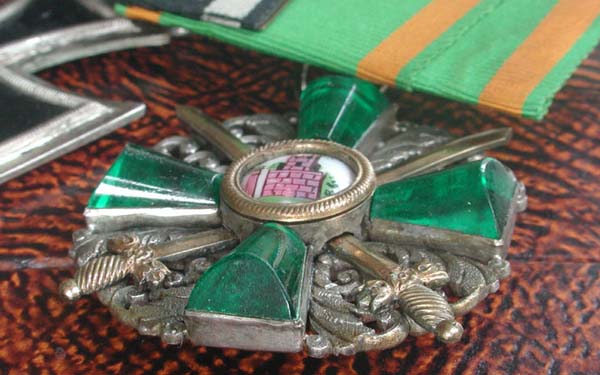
 0
0 -
Rear detail:
[attachmentid=14607]
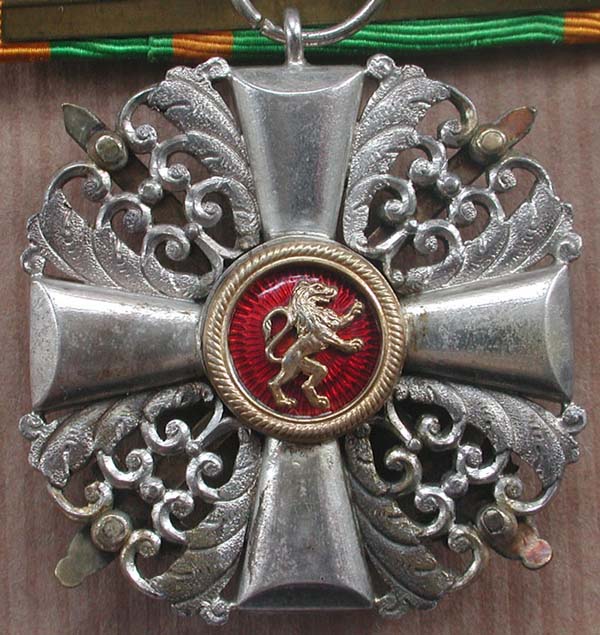
 0
0 -
Any clues as to the age of the Z?hringer L?we? A comparison of the centre suggests that it is "cheaper" than others seen in other threads.
Front detail:
[attachmentid=14606]
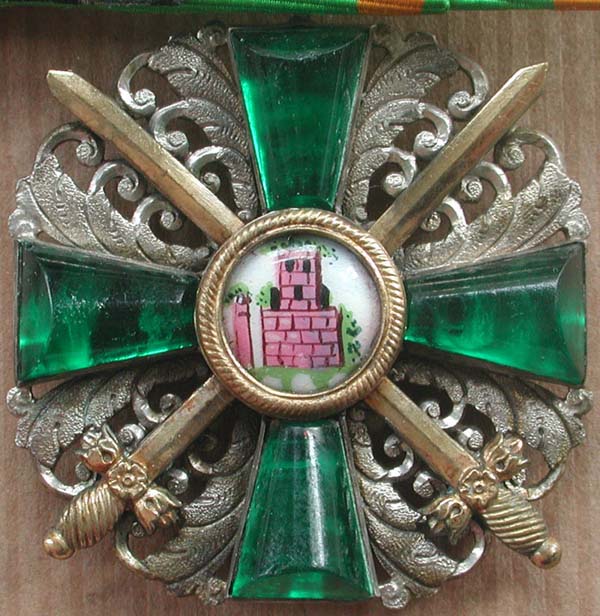
 0
0 -
The bar from the back.
[attachmentid=14604]
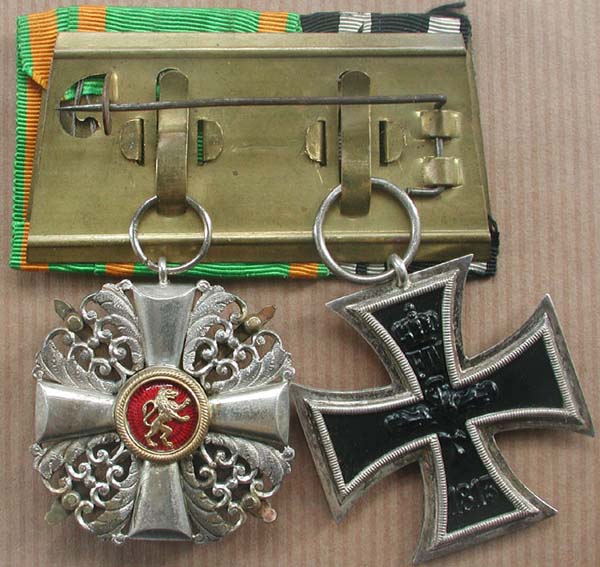
 0
0 -
This Z?hringer L?we 2nd class with swords lives next to an EK2 marked S-W.
[attachmentid=14602]
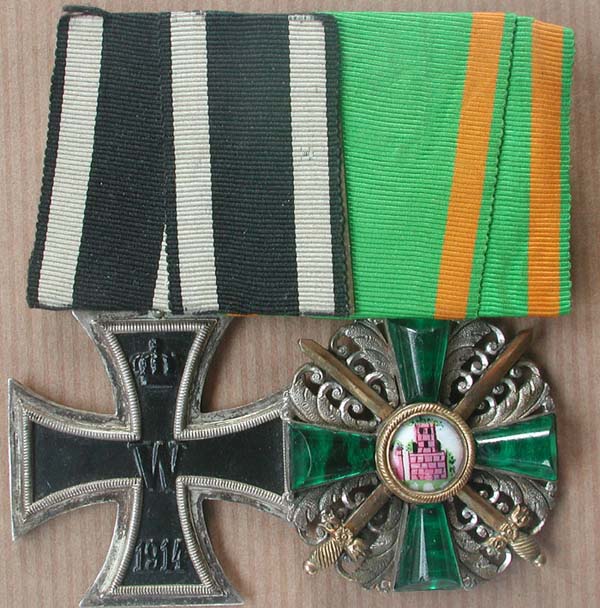
 0
0 -
Wow that's a first for me ... a screwback with the post on the cross itself. Can you imagine the pain if you got hit on the front of the cross with a 1/4 inch of that screwpost sticking through the plate behind the uniform

Under the circumstances, the pain caused by a 1/4 inch puncture wound might be the least of your worries!
David
0 -
What you have been told seems about right.
Early political items like this are not unusual but are beyond the realm of militaria for me.
/David
0 -
Typos:
Hanns instead of Hans and Haellmigk (instead of Hellmich?) seem obvious, but clues as to any others would be appreciated so that the lists can be corrected.
Thanks in advance,
David
0




Karl Friedrich Verdienst Orden
in Germany: Imperial: The Orders, Decorations and Medals of The Imperial German States
Posted
Dave,
That is a great piece of work.
I am in the process of cataloguing my documents so that I know what I have and who served with a particular unit at a given time.
One problem I have encountered is how to designate the various awards (primarily common awards from the various states to enlisted men and junior officers).
Are the abbreviations you use standardised in any way and do you know of accepted abbreviations for the EK "equivalents" (for want of a better word), e.g. Saxon bronze and silver FAM, Baden merit medal, Braunschweig 1st and 2nd class war merit cross, etc.?
David